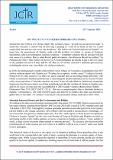The Politics of Cholera Epidemics in Zambia
Abstract
Given how Zambia has dealt with previous cholera outbreaks, it is not surprising that the current outbreak in Zambia continues to spread unabated. So far, it has affected a total of 39 districts in 9 provinces in Zambia. As of 11 January 2024, the Ministry of Health had reported 8,276 cumulative cases and 333 deaths, with a Case Fatality Rate (CFR) of 4%. 94% of all confirmed cases and 97% of all deaths in Zambia occurred in Lusaka Province. Given our history of urbanisation, this is no surprise. The main drivers of the outbreak are the poor water, sanitation, sewage and drainage conditions in densely populated urban/peri-urban unplanned settlements as well as localised floods caused by rains and contaminated water sources in the same areas. Although Zambia recently received 1.6 million cholera vaccination doses from WHO, vaccination is not a long-term solution.
Description
By the phrase “The Politics of Cholera Epidemics in Zambia” we mean how the government of Zambia deals with the problem of cholera by means of Statutory Instruments, which are nothing but band-aid solutions ― temporary solutions that do not deal with the root cause of a problem. Due to what French political scientist Jean-François Bayart has dubbed “La Politique du Ventre” (the Politics of the Belly), African politicians are unable to get to the root cause of the problem and solve it once and for all. This is true of how successive Zambian governments, including the current one, have dealt with cholera epidemics.
